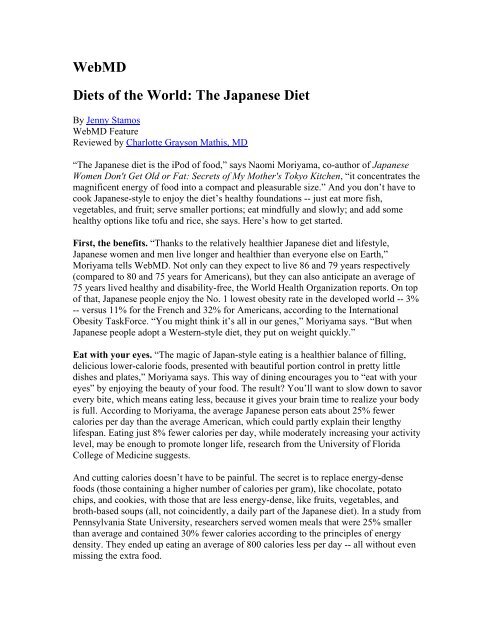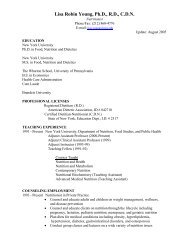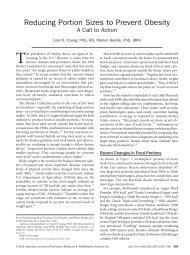WebMD Diets of the World: The Japanese Diet - The Portion Teller
WebMD Diets of the World: The Japanese Diet - The Portion Teller
WebMD Diets of the World: The Japanese Diet - The Portion Teller
Create successful ePaper yourself
Turn your PDF publications into a flip-book with our unique Google optimized e-Paper software.
<strong>WebMD</strong><br />
<strong><strong>Diet</strong>s</strong> <strong>of</strong> <strong>the</strong> <strong>World</strong>: <strong>The</strong> <strong>Japanese</strong> <strong>Diet</strong><br />
By Jenny Stamos<br />
<strong>WebMD</strong> Feature<br />
Reviewed by Charlotte Grayson Mathis, MD<br />
“<strong>The</strong> <strong>Japanese</strong> diet is <strong>the</strong> iPod <strong>of</strong> food,” says Naomi Moriyama, co-author <strong>of</strong> <strong>Japanese</strong><br />
Women Don't Get Old or Fat: Secrets <strong>of</strong> My Mo<strong>the</strong>r's Tokyo Kitchen, “it concentrates <strong>the</strong><br />
magnificent energy <strong>of</strong> food into a compact and pleasurable size.” And you don’t have to<br />
cook <strong>Japanese</strong>-style to enjoy <strong>the</strong> diet’s healthy foundations -- just eat more fish,<br />
vegetables, and fruit; serve smaller portions; eat mindfully and slowly; and add some<br />
healthy options like t<strong>of</strong>u and rice, she says. Here’s how to get started.<br />
First, <strong>the</strong> benefits. “Thanks to <strong>the</strong> relatively healthier <strong>Japanese</strong> diet and lifestyle,<br />
<strong>Japanese</strong> women and men live longer and healthier than everyone else on Earth,”<br />
Moriyama tells <strong>WebMD</strong>. Not only can <strong>the</strong>y expect to live 86 and 79 years respectively<br />
(compared to 80 and 75 years for Americans), but <strong>the</strong>y can also anticipate an average <strong>of</strong><br />
75 years lived healthy and disability-free, <strong>the</strong> <strong>World</strong> Health Organization reports. On top<br />
<strong>of</strong> that, <strong>Japanese</strong> people enjoy <strong>the</strong> No. 1 lowest obesity rate in <strong>the</strong> developed world -- 3%<br />
-- versus 11% for <strong>the</strong> French and 32% for Americans, according to <strong>the</strong> International<br />
Obesity TaskForce. “You might think it’s all in our genes,” Moriyama says. “But when<br />
<strong>Japanese</strong> people adopt a Western-style diet, <strong>the</strong>y put on weight quickly.”<br />
Eat with your eyes. “<strong>The</strong> magic <strong>of</strong> Japan-style eating is a healthier balance <strong>of</strong> filling,<br />
delicious lower-calorie foods, presented with beautiful portion control in pretty little<br />
dishes and plates,” Moriyama says. This way <strong>of</strong> dining encourages you to “eat with your<br />
eyes” by enjoying <strong>the</strong> beauty <strong>of</strong> your food. <strong>The</strong> result? You’ll want to slow down to savor<br />
every bite, which means eating less, because it gives your brain time to realize your body<br />
is full. According to Moriyama, <strong>the</strong> average <strong>Japanese</strong> person eats about 25% fewer<br />
calories per day than <strong>the</strong> average American, which could partly explain <strong>the</strong>ir lengthy<br />
lifespan. Eating just 8% fewer calories per day, while moderately increasing your activity<br />
level, may be enough to promote longer life, research from <strong>the</strong> University <strong>of</strong> Florida<br />
College <strong>of</strong> Medicine suggests.<br />
And cutting calories doesn’t have to be painful. <strong>The</strong> secret is to replace energy-dense<br />
foods (those containing a higher number <strong>of</strong> calories per gram), like chocolate, potato<br />
chips, and cookies, with those that are less energy-dense, like fruits, vegetables, and<br />
broth-based soups (all, not coincidently, a daily part <strong>of</strong> <strong>the</strong> <strong>Japanese</strong> diet). In a study from<br />
Pennsylvania State University, researchers served women meals that were 25% smaller<br />
than average and contained 30% fewer calories according to <strong>the</strong> principles <strong>of</strong> energy<br />
density. <strong>The</strong>y ended up eating an average <strong>of</strong> 800 calories less per day -- all without even<br />
missing <strong>the</strong> extra food.
<strong>Portion</strong> power. In Japan, food is served on separate small plates and bowls instead <strong>of</strong> on<br />
one big plate. Diners take turns having little tastes <strong>of</strong> everything, Moriyama says. Serving<br />
smaller portions may be one <strong>of</strong> <strong>the</strong> best secrets for eating healthfully and losing weight.<br />
Research shows that when we’re served more, we tend to eat it -- whe<strong>the</strong>r we planned to<br />
and were hungry for it or not. People eat up to 45% more food when served bigger<br />
helpings, scientists from <strong>the</strong> University <strong>of</strong> Illinois, Urbana-Champaign report. When<br />
asked to identify what determines <strong>the</strong> size <strong>of</strong> <strong>the</strong> portions <strong>the</strong>y eat, nearly seven out <strong>of</strong> 10<br />
respondents in a recent American Institute for Cancer Research (AICR) survey claimed<br />
that <strong>the</strong> amount <strong>the</strong>y were accustomed to eating was what determined <strong>the</strong> amount <strong>of</strong> food<br />
<strong>the</strong>y placed on <strong>the</strong>ir plates.<br />
This is both bad news and good news. Bad, in that it’s pro<strong>of</strong> we tend to eat without<br />
thinking. And good, in that it’s possible to change <strong>the</strong> amount <strong>of</strong> food we eat. How? By<br />
becoming used to eating less. For instance, try replacing platter-size dinner plates with<br />
salad or dessert plates. You’ll end up eating less, while barely noticing, because your<br />
plate will look just as full. Or try serving food from measuring cups for a week or so, says<br />
Lisa R. Young, PhD, RD, author <strong>of</strong> <strong>The</strong> <strong>Portion</strong> <strong>Teller</strong> Plan, -- just to get used to <strong>the</strong><br />
amount <strong>of</strong> food you should be eating. “You don't have to shrink all your portions, just<br />
portions <strong>of</strong> high-calorie, high-fat foods,” she says.<br />
A rice foundation. <strong>The</strong> <strong>Japanese</strong> diet includes huge amounts <strong>of</strong> rice -- six times more per<br />
person than <strong>the</strong> average American’s diet, Moriyama tells <strong>WebMD</strong>. A small bowl is<br />
served with almost every meal, including breakfast. A low-fat, complex carbohydrate,<br />
rice helps fill you up on fewer calories, leaving less room in your belly for fattening<br />
foods like packaged cookies and pastries, which can contain heart-damaging trans fats.<br />
For extra health benefits, serve rice <strong>the</strong> <strong>Japanese</strong> way, cooked and eaten with no butter or<br />
oil.<br />
Veggie delight.“Japan is kind <strong>of</strong> a vegetable-crazed nation,” Moriyama says. When<br />
<strong>Japanese</strong> women were asked which home-cooked meals <strong>the</strong>y most loved to prepare for<br />
<strong>the</strong>ir families, “mixed vegetables simmered in seasoned broth” received <strong>the</strong> highest<br />
ranking. Red bell peppers, green beans, zucchini, eggplant, onions, burdock, tomatoes,<br />
green peppers, lettuce, carrots, spinach, bamboo shoots, beets, lotus root, turnips, daikon<br />
(or giant white radish), shiitake mushrooms, sweet potatoes, and seaweed (or sea<br />
vegetables), such as kombu, nori, and wakame all have a place in <strong>the</strong> <strong>Japanese</strong> diet. As<br />
many as four or five different varieties are served in a single meal -- and no one thinks it<br />
odd to have vegetable soup or a salad for breakfast. Veggies are served simmered in<br />
seasoned broth, stir-fried in a small bit <strong>of</strong> canola oil, or lightly steamed -- all methods that<br />
maintain a maximum amount <strong>of</strong> nutrients.<br />
A good catch. Fish, especially fatty fish -- like <strong>Japanese</strong> favorite’s salmon and fresh tuna,<br />
mackerel, sardines, and herring -- are a great source <strong>of</strong> omega-3 fatty acids, which are<br />
known for <strong>the</strong>ir heart-health and mood-boosting benefits, Moriyama tells <strong>WebMD</strong>. And<br />
though Japan accounts for only 2% <strong>of</strong> <strong>the</strong> world’s population, its people eat 10% <strong>of</strong> <strong>the</strong><br />
world’s fish. <strong>The</strong> flipside <strong>of</strong> Japan’s fish craze means <strong>the</strong> <strong>Japanese</strong> eat less red meat,
which contains artery-clogging saturated fat that, if eaten to excess, can lead to obesity<br />
and heart disease.<br />
Soy good. When consumed in moderation, natural soy products like t<strong>of</strong>u and edamame<br />
beans are a great protein alternative to red meat because <strong>the</strong>y have little or no saturated<br />
fat, says Moriyama. <strong>Japanese</strong> meals <strong>of</strong>ten include more than one soy-based dish, like<br />
miso soup (miso is fermented soy beans) and chunks <strong>of</strong> t<strong>of</strong>u.<br />
Delicious desserts. A typical <strong>Japanese</strong> dessert is an assortment <strong>of</strong> seasonal fruits, peeled,<br />
sliced, and arranged on a pretty plate, Moriyama says. People do enjoy Western desserts<br />
like ice cream and cakes, but <strong>the</strong>y're usually <strong>of</strong>fered in smaller portions and subtler<br />
flavors compared to <strong>the</strong> West. A cup <strong>of</strong> <strong>Japanese</strong> green tea is <strong>the</strong> perfect end to any meal.<br />
Healthy options. It only takes a few small changes to make <strong>the</strong> <strong>Japanese</strong> diet even<br />
healthier. <strong>The</strong> first requires swapping <strong>the</strong> ubiquitous white rice for brown. Japan’s<br />
original ancient power food, brown rice is a great whole-grain, high-fiber source <strong>of</strong> “good<br />
carbs,” Moriyama says. <strong>The</strong> second change involves reducing sodium intake, which is<br />
much too high in <strong>the</strong> <strong>Japanese</strong> diet because <strong>of</strong> <strong>the</strong> large amounts <strong>of</strong> soy sauce and pickled<br />
foods. When available, choose <strong>the</strong> lower-sodium varieties <strong>of</strong> miso, soy sauce and teriyaki<br />
sauce, Moriyama says, -- and even <strong>the</strong>n, you should use <strong>the</strong>m in small amounts. On a<br />
piece <strong>of</strong> sushi for example, just a drop or two <strong>of</strong> lower-sodium soy sauce is all you need.<br />
Beautiful food. Bursting with beauty, taste, and health benefits, <strong>the</strong> <strong>Japanese</strong> diet has<br />
something to <strong>of</strong>fer anyone who wants to live longer, slimmer, and healthier. Experiment<br />
with fish, rice, or vegetables served on your most delicate dishes, and reap <strong>the</strong> benefits<br />
for yourself -- chopsticks not required.<br />
SOURCES: Naomi Moriyama, co-author <strong>of</strong> <strong>Japanese</strong> Women Don't Get Old or Fat:<br />
Secrets <strong>of</strong> My Mo<strong>the</strong>r's Tokyo Kitchen. Moriyama, N. and Doyle W. <strong>Japanese</strong> Women<br />
Don't Get Old or Fat: Secrets <strong>of</strong> My Mo<strong>the</strong>r's Tokyo Kitchen. Delta, reprint edition, 2006.<br />
Lisa R. Young, PhD, RD, nutrition researcher, New York University; author <strong>of</strong> <strong>The</strong><br />
<strong>Portion</strong> <strong>Teller</strong>. <strong>World</strong> Health Organization, <strong>World</strong> Health Report, 2006. <strong>World</strong> Health<br />
Organization, <strong>World</strong> Health Report, 2003. International Obesity TaskForce <strong>of</strong> <strong>the</strong><br />
International Association for <strong>the</strong> Study <strong>of</strong> Obesity: Global Obesity Prevalence in Adults.<br />
Seo, A.Y. Antioxid Redox Signal. March-April 2006; vol 8: pp 529-538. <strong>WebMD</strong><br />
Feature: “Satiety: <strong>The</strong> New <strong>Diet</strong> Weapon.” Rolls, B., Roe, L., Meengs, J. American<br />
Journal <strong>of</strong> Clinical Nutrition, January 2006; vol 83: pp 11-17. <strong>WebMD</strong> Medical News:<br />
“Big <strong>Portion</strong>s May Prompt Overeating.” <strong>WebMD</strong> Feature: “Why Mindless Eating Can<br />
Pack on Pounds.” American Institute for Cancer Research (AICR), survey on portion<br />
size, Feb 22, 2006.<br />
Reviewed on February 13, 2007<br />
© 2007 <strong>WebMD</strong>, Inc. All rights reserved.<br />
©2005-2007 <strong>WebMD</strong>, Inc. All rights reserved.




